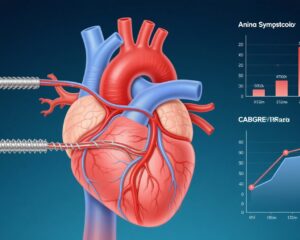Highlight
• The mitochondrial sORF-encoded peptide MODICA is downregulated by doxorubicin (DOX) cardiotoxicity.
• MODICA localizes to the outer mitochondrial membrane and suppresses voltage-dependent anion channel (VDAC) oligomerization.
• Cardiac-specific overexpression of MODICA improves cardiac function and reduces fibrosis in a mouse DOX cardiotoxicity model.
• MODICA deficiency exacerbates DOX-induced cardiac injury, linking its modulation to mitochondrial protection and apoptosis inhibition.
Study Background and Disease Burden
Doxorubicin, a widely used anthracycline chemotherapeutic agent, remains a cornerstone in treating various malignancies, including breast cancer, lymphomas, and sarcomas. However, its clinical use is limited by a well-recognized dose-dependent cardiotoxicity, which significantly elevates cardiovascular morbidity and mortality among cancer survivors. This cardiotoxicity primarily manifests as progressive myocardial dysfunction leading to heart failure. The underlying pathophysiology involves oxidative stress, mitochondrial damage, and apoptosis in cardiomyocytes, though the precise molecular mechanisms remain incompletely elucidated.
Emerging evidence underscores the critical role of mitochondrial integrity in cardiomyocyte survival and function. Short open reading frame-encoded peptides (sORF-encoded peptides) derived from mitochondrial transcripts—previously underappreciated bioactive molecules—are increasingly recognized as modulators of mitochondrial dynamics and function. Whether these mitochondrial sORF-encoded peptides can mitigate doxorubicin-induced cardiac injury had not been previously established.
Study Design
This experimental study employed in vivo murine models to investigate the cardiac protective potential of mitochondrial sORF-encoded peptides against doxorubicin cardiotoxicity. Five peptides, including MODICA (mito-SEP protector against DOX-induced cardiac injury), were expressed specifically in cardiomyocytes using adeno-associated viruses (AAVs) under the cardiac troponin T promoter.
Adult male and female C57BL/6 mice were randomized to receive either AAV-CTRL or AAV-MODICA, then treated with saline or doxorubicin. Sample sizes varied across groups (males saline-CTRL n=4, saline-MODICA n=4, DOX-CTRL n=11, DOX-MODICA n=10; females saline-CTRL n=8, saline-MODICA n=10, DOX-CTRL n=10, DOX-MODICA n=13). Additionally, MODICA-heterozygous mice generated by CRISPR/Cas9 were studied to evaluate the effects of peptide deficiency.
Echocardiography assessed cardiac function at baseline and after two weeks of DOX treatment. Myocardial tissues and sera were collected for molecular profiling, proteomics, histology, and RNA sequencing analyses to delineate the mechanisms by which MODICA influences cardiotoxic injury.
Key Findings
Identification and Expression of MODICA
MODICA was identified by biochemical screening and functional assays as a mitochondrial sORF-encoded peptide with cardioprotective potential. It predominantly localizes to the outer mitochondrial membrane (OMM). DOX treatment significantly reduced MODICA expression in myocardium (normalized expression 1.00±0.08 in controls vs. 0.42±0.09 post-DOX; P < 0.001), indicating a possible link between its depletion and cardiotoxic injury.
Functional Cardiac Protection by MODICA Overexpression
Cardiac-specific MODICA overexpression via AAV delivery robustly attenuated DOX-induced cardiac dysfunction in both sexes. Echocardiographic fractional shortening (FS) was markedly preserved in the DOX-MODICA group versus DOX-CTRL: males 51.54% vs. 38.86% (P < 0.001), females 51.39% vs. 39.81% (P < 0.001). These improvements were corroborated by bulk RNA sequencing analyses, showing favorable transcriptomic modifications consistent with enhanced mitochondrial and cellular homeostasis.
MODICA Deficiency Worsens DOX Cardiotoxicity
MODICA heterozygous mice displayed significantly worse cardiac function after DOX administration compared with wild-type counterparts (fractional shortening 31.85% vs. 40.37%; P < 0.001). Histological examination revealed increased cardiac fibrosis (P = 0.009), underscoring MODICA’s endogenous role in cardiac resilience to chemotoxic insult.
Molecular Mechanisms: Inhibition of VDAC Oligomerization
Proteomic analyses unveiled that MODICA interacts directly with voltage-dependent anion channels (VDACs), key apoptosis regulators located on the OMM. DOX induces pathological VDAC oligomerization facilitating mitochondrial permeability transition pore formation, leading to mitochondrial membrane potential collapse and cardiomyocyte apoptosis.
MODICA suppresses DOX-induced VDAC oligomerization (P < 0.001), reducing mitochondrial permeability transition and downstream apoptotic cascades. This effect preserves calcium handling and mitochondrial integrity, thereby protecting cardiomyocytes from DOX-induced injury and reducing cell death.
Expert Commentary
The study by Wu et al. delineates a novel cardioprotective mitochondrial peptide, MODICA, that directly targets a critical step in the apoptotic pathway triggered by doxorubicin. This insight advances our understanding beyond traditional mechanisms of DOX cardiotoxicity, emphasizing mitochondrial outer membrane modulation and sORF-encoded peptides as emerging therapeutic targets.
While the findings are compelling, translation from murine models to human clinical application requires further validation. The heterozygous model shows dose-dependent protective effects, but the potential for complete loss or overexpression toxicity remains to be clarified. Also, long-term studies assessing effects on tumor efficacy and cardiac remodeling are warranted.
Integrating MODICA-based strategies with current cardio-oncology care might complement existing approaches such as dexrazoxane, antioxidant therapies, and more targeted chemotherapeutic regimens by directly safeguarding mitochondrial function.
Conclusion
This research identifies MODICA as a mitochondrial sORF-encoded peptide that mitigates doxorubicin-induced cardiac injury by inhibiting VDAC oligomerization, thereby reducing mitochondrial permeability and cardiomyocyte apoptosis. The peptide’s downregulation by DOX and the reciprocal detrimental effect of its deficiency highlight its physiologic role in cardiac mitochondrial homeostasis.
MODICA represents a promising therapeutic target that could be exploited to prevent or attenuate anthracycline cardiotoxicity, a major limitation of current cancer therapy. Future studies are needed to develop MODICA-based cardioprotective agents and to evaluate their safety and efficacy in clinical settings.
References
Wu J, Li K, Yan Y, et al. Mitochondrial sORF-Encoded Peptide MODICA Protects the Heart From Doxorubicin-Induced Cardiac Injury by Suppressing VDAC Oligomerization. Circ Heart Fail. 2025 Sep 4:e013381. doi:10.1161/CIRCHEARTFAILURE.125.013381. Epub ahead of print. PMID: 40905126.
Octavia Y, Tocchetti CG, Gabrielson KL, Janssens S, Crijns HJ, Moens AL. Doxorubicin-induced cardiomyopathy: from molecular mechanisms to therapeutic strategies. J Mol Cell Cardiol. 2012 Jun;52(6):1213-25. doi:10.1016/j.yjmcc.2012.03.006.
Zhang X, Wang Y, Xu S, et al. Small peptides encoded by short open reading frames: more than microproteins? Protein Cell. 2020 May;11(5):377-392. doi: 10.1007/s13238-019-00679-5.


